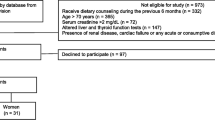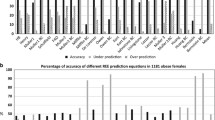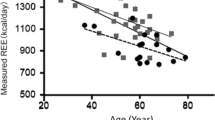Abstract
Background
Determination of resting energy expenditure (REE) is an important step for the nutritional and medical care of patients with chronic kidney disease (CKD). Methods such as indirect calorimetry or traditional predictive equations are costly or inaccurate to estimate REE of CKD patients. We aimed to develop and validate predictive equations to estimate the REE of non-dialysis dependent-CKD patients.
Methods
A database comprising REE measured by indirect calorimetry (mREE) of 170 non-dialysis dependent-CKD patients was used to develop (n = 119) and validate (n = 51) a new REE-predictive equation. Fat free mass (FFM) was assessed by anthropometry and by bioelectrical impedance (BIA).
Results
The multiple regression analysis generated three equations: (1) REE (kcal/day) = 854 + 7.4*Weight + 179*Sex – 3.3*Age + 2.1 *eGFR + 26 (if DM) (R2 = 0.424); (2) REE (kcal/day) = 678.3 + 14.07*FFM.ant + 54.8*Sex – 2*Age + 2.5*eGFR + 140.7* (if DM) (R2 = 0.449); (3) REE (kcal/day) = 668 + 17.1*FFM.BIA – 2.7*Age − 92.7*Sex + 1.3*eGFR − 152.3 (if DM) (R2 = 0.45). The estimated REE (eREE) was not different from the mREE (P = 0.181), a high ICC was found and the mean difference between mREE and eREE was not different from zero for the three equations in the validation group. eREE accuracy between 90 and 110% was observed in 55.3%, 62.5% and 61% of the patients for Eqs. (1), (2) and (3), respectively.
Conclusion
The equations showed acceptable accuracy for REE prediction making them a valuable tool to support practitioners to provide more reliable energy recommendations for this group of patients.



Similar content being viewed by others
References
Bikbov B, Purcell CA, Levey AS, Smith M, Abdoli A, Abebe M et al (2020) Global, regional, and national burden of chronic kidney disease, 1990–2017: a systematic analysis for the Global Burden of Disease Study 2017. Lancet
Avesani CM, Kamimura MA, Cuppari L (2011) Energy expenditure in chronic kidney disease patients. J Ren Nutr 21(1):27–30
Ortiz A, Sanchez-ni MD (2019) Sarcopenia in CKD : a roadmap from basic pathogenetic mechanisms to clinical trials ~ o. Clin Kidney J 12(1):110–112
Kopple JD, Feroze U (2011) The effect of obesity on chronic kidney disease. J Ren Nutr (Internet) 21(1):66–71
Oshima T, Berger MM, De Waele E, Guttormsen AB, Heidegger CP, Hiesmayr M et al (2017) Indirect calorimetry in nutritional therapy. A position paper by the ICALIC study group. Clin Nutr. 36(3):651–662
Kamimura MA, Avesani CM, Bazanelli AP, Baria F, Draibe SA, Cuppari L (2011) Are prediction equations reliable for estimating resting energy expenditure in chronic kidney disease patients? Nephrol Dial Transplant 26(2):544–550
Avesani CM, Draibe SA, Kamimura MA, Dalboni MA, Basile Colugnati FA, Cuppari L (2004) Decreased resting energy expenditure in non-dialysed chronic kidney disease patients. Nephrol Dial Transplant 19(12):3091–3097
Vilar E, Machado A, Garrett A, Kozarski R, Wellsted D, Farrington K (2014) Disease-specific predictive formulas for energy expenditure in the dialysis population. J Ren Nutr 24(4):243–251
Byham-Gray LD, Parrott JS, Peters EN, Fogerite SG, Hand RK, Ahrens S et al (2018) Modeling a predictive energy equation specific for maintenance hemodialysis. J Parenter Enter Nutr 42(3):587–596
Fernandes TO, Avesani CM, Kamimura MA, Aoike DT, Cuppari L (2019) Estimating resting energy expenditure of patients on dialysis: development and validation of a predictive equation. Nutrition 67–68:1–8
Avesani CM, Draibe SA, Kamimura MA, Basile Colugnati FA, Cuppari L (2004) Resting energy expenditure of chronic kidney disease patients: influence of renal function and subclinical inflammation. Am J Kidney Dis 44(6):1008–1016
Utaka S, Cm A, Sa D, Ma K, Andreoni S, Cuppari L (2005) Inflammation is associated with increased energy expenditure in patients with chronic kidney disease. Am J Clin Nutr 82(4):801–805
Weir JdV (1948) New methods for calculating metabolic rate with special reference to protein metabolism. J Physiol. 109(5):1–9
Durnin JVGA, Womersley J (1974) Body fat assessed from total body density and its estimation from skinfold thickness: measurements on 481 men and women aged from 16 to 72 years. Br J Nutr 32(01):77–97
Levey AS, Stevens LA, Schmid CH, Zhang YL, Iii AFC, Feldman HI et al (2006) Article annals of internal medicine a new equation to estimate glomerular filtration rate. Ann Intern Med 150(9):604–612
Hair Jr JF, Black WC, Barry JB, Anderson RE (2014) Multivariate data analysis, 7th edn
Harris JA, Benedict FG (1918) A Biometric Study of Human Basal Metabolism. Proc Natl Acad Sci 4(12):370–373
Schofield W (1985) Predicting basal metabolic rate, new standards and review of previous work. Hum Nutr Clin Nutr 39(Suppl 1):5–41
Sridharan S, Wong J, Vilar E, Farrington K (2016) Comparison of energy estimates in chronic kidney disease using doubly-labelled water. J Hum Nutr Diet 29(1):59–66
Sullivan AJO, Lawson JA, Chan M, Kelly JJ, Al OSET (2002) Body composition and energy metabolism in chronic renal insufficiency. Am J Kidney Dis 39(2):369–375
Kuhlmann U, Schwickardi M, Trebst R, Lange H (2001) Resting metabolic rate in chronic renal failure. J Ren Nutr 11(4):202–206
Wang Z, Ying Z, Bosy-westphal A, Zhang J, Schautz B, Later W et al (2010) Specific metabolic rates of major organs and tissues across adulthood: evaluation by mechanistic model of resting energy expenditure. Am J Clin Nutr 1–4:4
Slee AD (2012) Exploring metabolic dysfunction in chronic kidney disease. Nutr Metab 9(36):1–16
Willis EA, Herrmann SD, Ptomey LT, Honas JJ, Bessmer CT, Donnelly JE et al (2016) Predicting resting energy expenditure in young adults. Obes Res Clin Pract 10(3):304–314
Almajwal AM, Abulmeaty MMA (2019) New predictive equations for resting energy expenditure in normal to overweight and obese population. Int J Endocrinol 1–15
Adey D, Kumar R, McCarthy JT, Sreekumaran NK (2000) Reduced synthesis of muscle proteins in chronic renal failure. Am J Physiol Endocrinol Metab 278(2412):219–225
Thome T, Salyers ZR, Kumar RA, Hahn D, Berru FN, Ferreira LF et al (2019) Uremic metabolites impair skeletal muscle mitochondrial energetics through disruption of the electron transport system and matrix dehydrogenase activity 4. Am J Physiol Cell Physiol 317(4):C701–C713
Avesani CM, Cuppari L, Silvaa C, Sigulem DM, Cendoroglo M, Sesso R et al (2001) Resting energy expenditure in pre-dialysis diabetic patients. Nephrol Dial Transplant 16(960):556–565
Caron N, Peyrot N, Caderby T, Verkindt C, Dalleau G (2016) Energy expenditure in people with diabetes mellitus: a review. Front Nutr 3:1–10
Piaggi P, Thearle MS, Bogardus C, Krakoff J (2015) Fasting hyperglycemia predicts lower rates of weight gain by increased energy expenditure and fat oxidation rate. J Clin Endocrinol Metab 100(3):1078–1087
Funding
This study was supported by Fundação Oswaldo Ramos. Lilian Cuppari receives a scholarship from the Conselho Nacional de Desenvolvimento Científico e Tecnológico (CNPq) 302765/2017-4.
Author information
Authors and Affiliations
Contributions
TOF and LC conceptualized the study design and wrote the manuscript; CMA conceptualized the study and performed data collection; TOF and DAT performed statistical analysis and data interpretation. All authors revised the manuscript and provided important intellectual considerations.
Corresponding author
Ethics declarations
Conflict of interest
We herein state that none of the information and material in this manuscript is included in another manuscript, has been published previously, or is currently under consideration for publication elsewhere.
Additional information
Publisher's Note
Springer Nature remains neutral with regard to jurisdictional claims in published maps and institutional affiliations.
Rights and permissions
About this article
Cite this article
de Oliveira Fernandes, T., Avesani, C.M., Aoike, D.T. et al. New predictive equations to estimate resting energy expenditure of non-dialysis dependent chronic kidney disease patients. J Nephrol 34, 1235–1242 (2021). https://doi.org/10.1007/s40620-020-00899-7
Received:
Accepted:
Published:
Issue Date:
DOI: https://doi.org/10.1007/s40620-020-00899-7




